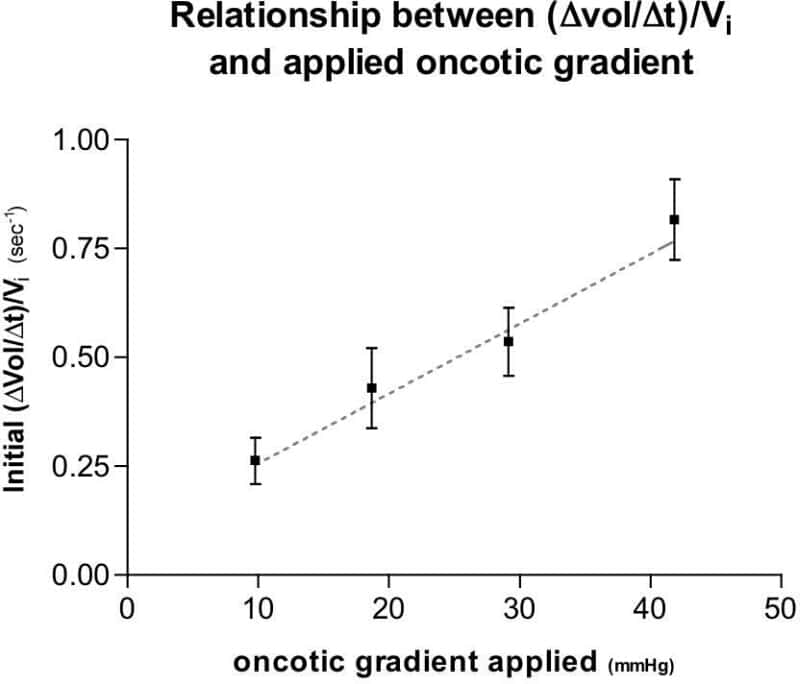Vascular Endothelial Growth Factor (VEGF) potently increases systemic microvascular permeability to water (Bates & Curry, 1996), and is produced by glomerular cells (podocytes) (Bailey et al. 1999). We have refined the methods of Savin and colleagues (Savin & Terreros, 1981) to examine the effect of VEGF on the filtration characteristics of whole isolated glomeruli ex vivo. Adult male Wistar rats were anaesthetised with 5% halothane, and killed by cervical dislocation. Glomeruli were isolated using a standard sieving technique with mammalian Ringer solution containing 1% bovine serum albumin (BSA), and incubated in either control or VEGF (1nM)-containing solution for up to 3 hours. Glomeruli were individually loaded onto a suction micropipette and exposed to a flowing superperfusate of 1%BSA (in Ringer solution) at 37°C. Switching the superperfusate to a solution containing a higher BSA concentration (4-8%; in Ringer solution; Fig. 1) created a transglomerular oncotic gradient. Consequent fluid efflux caused a reduction in glomerular volume, which was recorded on videotape and measured off-line. The initial rate of change of glomerular volume was used to calculate glomerular ultrafiltration coefficient (LpA). A significant correlation between initial glomerular volume (Vi) and LpA was noted (p<0.005; Spearman r = 0.45; n=47); henceforth LpA values are corrected for Vi (LpA/Vi; min-1.mmHg-1). Control LpA/Vi values failed to display normal distribution. A linear relationship was demonstrated between the initial rate of volume change per unit Vi [(Δvol/Δt)/Vi] and the magnitude of the oncotic gradient applied (p<0.001; Spearman r = 0.59; n=28) (figure 1). LpA/Vi values of glomeruli exposed to VEGF for 56 (mean) ±5 (S.E.M.) minutes were significantly higher [1.95±1.58; median±interquartile range (IQR); n=9] than those exposed to control solution (0.94±0.89; n=10) (p<0.01, Mann Whitney). Neither VEGF exposure for 15 minutes {paired LpA/Vi: baseline 1.04 (0.77-1.96) [median (range)] vs VEGF 0.87 (0.60-2.03); p>0.6, Wilcoxon; n=5 pairs} nor 30 seconds [paired LpA/Vi: baseline 1.07±0.49 (median±IQR) vs VEGF 0.98±0.43; p>0.7, Wilcoxon; n=10 pairs] elicited a rise in LpA/Vi over baseline. These results show that prolonged exposure to exogenous VEGF can increase the ultrafiltration coefficient of renal glomeruli, ex vivo.
King's College London (2005) J Physiol 565P, C11
Communications: Vascular Endothelial Growth Factor increases the ultrafiltration coefficient of isolated rat glomeruli
Salmon, A HJ; Bates, D O; Harper, S J;
1. Department of Physiology, University of Bristol, Bristol, United Kingdom.
View other abstracts by:
Where applicable, experiments conform with Society ethical requirements.

